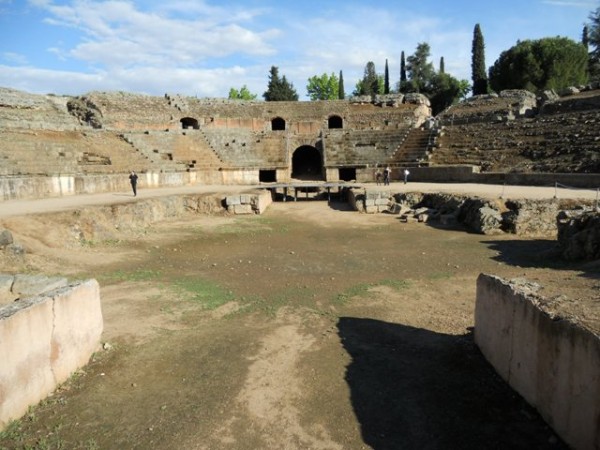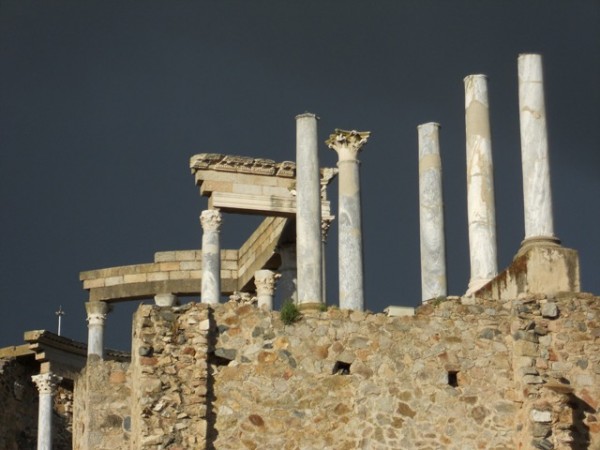 Merida was intended as little more than an overnight stop. We were travelling eastwards from Lisbon; it was Easter Sunday and the transport connections, poor at the best of times between Portugal and Spain, could not be trusted to take us beyond Merida in a single day. Being such a major holiday we also decided to book ahead, just in case the whole of provincial Spain shut down to mark the occasion. We were in for a pleasant surprise.
Merida was intended as little more than an overnight stop. We were travelling eastwards from Lisbon; it was Easter Sunday and the transport connections, poor at the best of times between Portugal and Spain, could not be trusted to take us beyond Merida in a single day. Being such a major holiday we also decided to book ahead, just in case the whole of provincial Spain shut down to mark the occasion. We were in for a pleasant surprise.

From the moment we arrived at the bus station in mid-afternoon and wandered through the narrow streets, shaded partially from the pleasant sunshine, it was clear that we had underestimated the size of Merida. Cafes were filled with customers, relaxing after their lunches and watching the world go by at a conspicuously slow pace.

Despite my almost total failure to research anything about Merida in advance of our arrival I was aware of its Roman heritage. I had assumed however that everything would be shut on Easter Sunday, and as we had an early train to catch the next day, that would be that. We were pleasantly surprised to learn that in fact rather than closing, the Roman site was remaining open until 9pm in recognition of the holiday. Imagine that happening here in the UK!

Merida’s Roman treasures deserve far more time that we gave them, but we were just grateful to get the chance to see them at all. So what is there to see?
8 Euros buys admission to the amphitheatre and theatre complex. An audioguide is available for an additional 3 Euros. I highly recommend the audio guide as there are no interpretation boards around the site and without the guide it is very difficult to appreciate the rich history of Merida, its importance in the Iberia of Roman days and of the events that took place in these ruins.
 Merida’s construction began around 20BC under the instruction of the consul Agrippa Vipsanio. In its day it was the most important city in the region, and the shows that took place in the theatre and amphitheatre would have attracted crowds of thousands from many miles around and from every class of Roman society. A strict system of social apartheid meant that everyone knew where they could and could not sit. Music, tragedy, parody and ritual slaughter were commonplace in these giant open air structures.
Merida’s construction began around 20BC under the instruction of the consul Agrippa Vipsanio. In its day it was the most important city in the region, and the shows that took place in the theatre and amphitheatre would have attracted crowds of thousands from many miles around and from every class of Roman society. A strict system of social apartheid meant that everyone knew where they could and could not sit. Music, tragedy, parody and ritual slaughter were commonplace in these giant open air structures.
 Using the audio guide in its entirety a wander through the site will take around 90 minutes and will introduce the visitor to some of the characters who may have called Merida home and offer a little insight into their lives. I always find these bits of the guides the most interesting, and it is the personal anecdotes that I take away from such a visit.
Using the audio guide in its entirety a wander through the site will take around 90 minutes and will introduce the visitor to some of the characters who may have called Merida home and offer a little insight into their lives. I always find these bits of the guides the most interesting, and it is the personal anecdotes that I take away from such a visit.

As we made our way around the site we noticed the sky slowly growing blacker and the wind starting to pick up. Before long the distant rumbles of thunder grew nearer, echoing menacingly around the Roman theatre. We didn’t make it back to the entrance in time, and as we discovered finding shelter from a storm when surrounded by Roman ruins is not easy!

There are other Roman treasures to be found within the city of Merida, and while we only managed a brief look at the Temple of Diana before hunger drove us indoors, we would gladly have stayed another day to get to know the city a little better.




